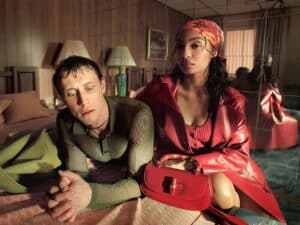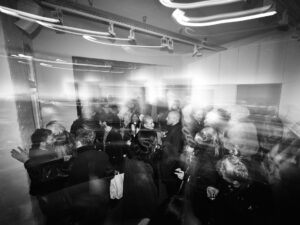While fashion has always been a means of self-expression and identity, the portrait series Exactitudes – a project that is both in the realm of a street style blog and sociological study – questions the nature of individualism and togetherness at the same time.
REPRINT: EXACTITUDES!
The conversation between Sam Kavangah and Ari was first published in the current print issue exploring the discourse around ‚I,‘ which can be found in stores and ONLINE
The year 1994 was a year of many moments. Nirvana performed their last concert in Munich, with Kurt Cobain later sending legions of fans into a frenzy from his suicide; the PlayStation was released, creating young gamers all over the world; and fashion got more universal with Calvin Klein releasing its infamous unisex fragrance, CKOne. While there were many cultural moments of ’94, in Rotterdam, there was a new movement and reckoning happening. Exactitudes was, and still is, the project masterminded by Dutch photographer Ari Versluis and “profiler” Ellie Uyttenbroek, who set out to look at not only similar street style-like profiles, but also understand society’s need for individuality while still remaining part of a group. Each individual is photographed and arranged on a 3×4 grid with identical poses, which cements the overall look of the character they are presenting.
The Exactitudes project today spans over 26 years, which has involved both Versluis and Uyttenbroek travelling around the globe from London to Paris to Berlin to Rio to Beijing, finding participants whose fashions interweave with their identity. In this collective societal way of thinking, it begs the question of collectiveness and individualism. Does one lose their individuality if they conform to a wider ‘tribe’, or is the tribe a part of an individual collective? Fräuleinspoke with both Ari and Ellie on what they set out with in Exactitudes, fashion as a universal language of expression, and reclaiming the individual.
Words by Sam Kavangah
What were you expecting to discover when you first started compiling Exactitudes back in 1994?
Ari: We did not expect anything – it was just very addictive to make this series. A methodology was created for understanding and being involved with fashion and identity in our own autonomous way. By sharpening our observations and encounters, we intensified the world around us.
What has been the biggest shift in your understanding of subcultures and the individual since the project started?
Ari: Subcultures work around the notion of tribalism: You and the Other, You as Me, Me as You. Understanding the Other and becoming aware of a different set of subcultural perspectives and motives to dress and impress in a certain way is key. We strived for a quite dry, anthropological record of people and their attempt to distinguish themselves from others by assuming a group identity. Today, people identify less with just one specific group, they commit less and their individuality is the highest good, even if they know by now that authenticity does not really exist. But then the possibilities to express yourself – especially in the synthetic world – seem endless now, resulting in either FOMO or making no choices at all. Paradoxically, when you set aside the notion of traditional subcultures and walk the streets in current times now, there is even more uniformed identity to be seen than ever.
Fashion is an important language of expression. What do you think of expressing yourself via clothing?
Ari: Fashion is not What, but How you wear it. Super conscious or very unconscious .Some people talk poetry, some sing protest songs or gospels, some rap vulgar and they like it. Exactitudes is about finding the essential details of expression, the right tone of voice or song, that can make a specific Exactitudes series socially and culturally relevant.
How much of your work is shaped by fashion as opposed to the singular person you are capturing?
Ari: It is a total interaction, but the people come first, they walk the walk, they talk the talk. Watching, observing and thinking: Hell, yes, this look most be captured! And then, of course, the whole process of fashion contextualization will lead to perfect fine-tuning in selecting who will be included in the series or not.
Do you create the individual looks for each model in each series?
Ari: We never dress the participant. The way we see them manifesting themselves in the streets, in the clubs, in the shopping mall, etc., that is how they are portrayed in the studio after making a proper appointment to do so.We always start with our first-encountered icon, the rest will follow.
Are there any particular groups which hold a special place in your heart? Why?
Ari: Due to the cyclical nature of fashion and the enormous time span we have been working on the oeuvre, new favorite series and groups always emerge that resonate with the heartbeat of the current times.
How would you describe your approach to seeking groups? How has it changed since you started the project in 1994?
Ari: Exactitudes is pretty much based in a pre-internet time. So we had to go out on the streets, into the clubs to find people. Nowadays, people have a synthetic and an organic life. Post-normcore during the day, multidimensional, layered and bubbled online.
Social media has taken over the function of life in public or private spaces, so casting online, especially with millennials and Gen Z, is an option but not one we favor. Life is too 3-dimensional for us, you can “smell” the person through your screen.
Subcultures influence your work – or at least more so than straightforward, conventional types of people. What does subculture mean to you, and how has it shaped your output?
Ari: We don’t care that much about subcultures, although it is super effective in communicating the Exactitudes approach. The audience instantly understands what the core of our fascination is. But, actually, it’s far more the common and ordinary people – the straightforward, conventional people as you name them – we like to portray. We try to make the invisible visible, categorize the peculiar. They become subcultures for us. We like to turn the game around, so to say.
How did you both grow up? Were you influenced by any type of individual which then came through via your work?
Ari: I was raised in a slow and small Protestant village in the Netherlands. When I saw the Sex Pistols on the telly in 1978, my life accelerated.
Ellie: I was born in Rotterdam and still live here. Art school changed my view on everything. During our travels, I have always been most attracted to the old people we portrayed. The way old people dress, as if they have grown into their identity, is of great beauty to me.
What projects have you got coming up?
Ari: During Covid times, we started to think about expanding the Exactitudes method and producing new grids worldwide by introducing EXA Associates. An open call will be announced on our channels later this year. And, by popular demand, we are developing an exclusive selection of poster-size reproductions of the work. Collect them all!
Image Courtesy of the Artists



